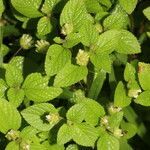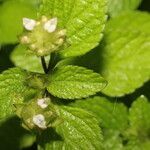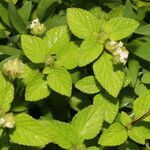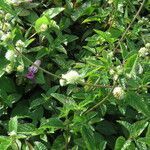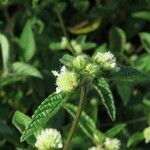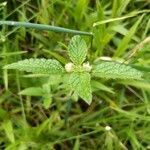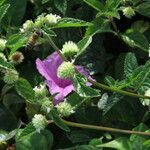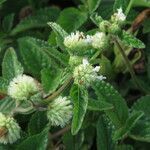Herbs, slender, prostrate, rooting at the nodes, stems to 3 m long, lightly pubescent. Leaves ovate, acute, crenate-serrate, the bases rounded and attenuate, 2.5-3.5 cm long and 1-1.5 cm wide, sparsely pubescent, resin-dotted; petioles ca 0.5-1.5 cm long, narrowly margined. Inflorescences capitula, axillary, hemis-pheric, 8-10 mm in diam, the peduncles ca 0.5-2.5 cm long, the bracts obovate, 4-.6 mm long, ciliate. Flowers sessile, tufts of hair at the bases; calyx tubular, ca 3.5-4 mm long at maturity, naked within, the teeth acicular to setaceous, ca 1-1.2 mm long, pubescent between; corolla ca 4-5 mm long, white, the lower lip ca 1 mm long, pubescent; stamens shortly exserted, the filaments lightly pubescent, the anthers ca 0.2 mm long; gynobase weakly lobed, the style ca 4-5 mm long, minutely bifid near the tip. Nutlets 4, ovoid-oblong, ca 0.6-0.8 mm long, the pericarp verrucose.
More
A slender herb that lies along the ground. It forms roots at the nodes. The stems are 3 m long. They are slightly hairy. The leaves are oval and have teeth along the edge. They are 2.5-3.5 cm long by 1-1.5 cm wide. They are slightly hairy. The flowers don't have stalks but have a tuft of hairs at the base. They are in round heads in the axils of the leaves. There are 4 nutlets that are oval and 0.6-0.8 mm long.
Globose, terminal and axillary heads 3/4 in. diam. of small flowers
Corolla white with mauve marks on the lip.
A straggling, aromatic herb
